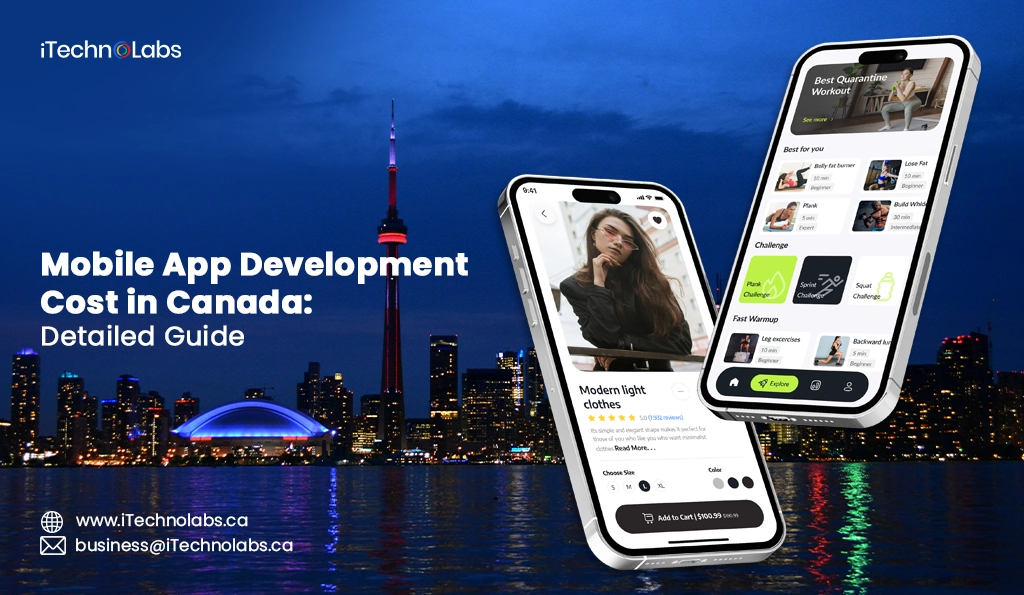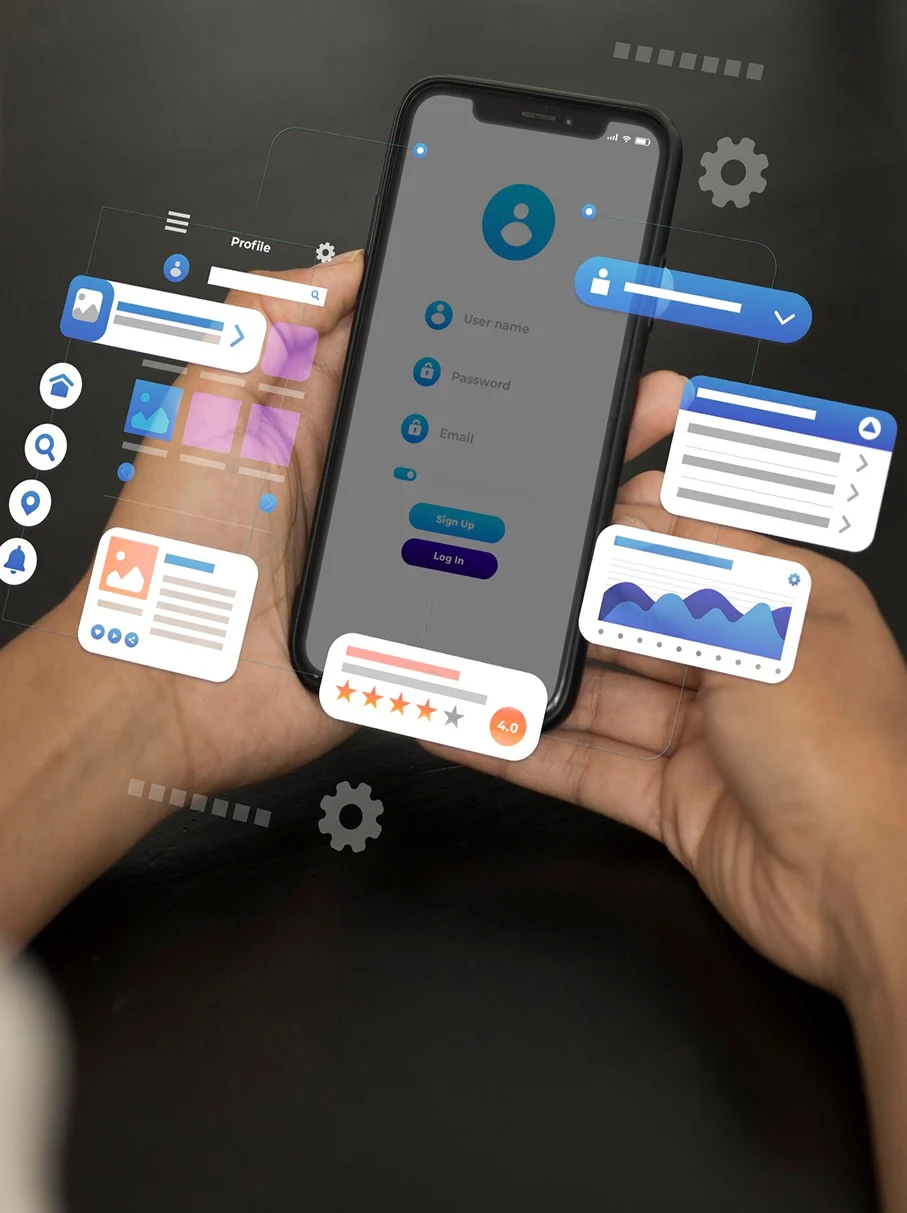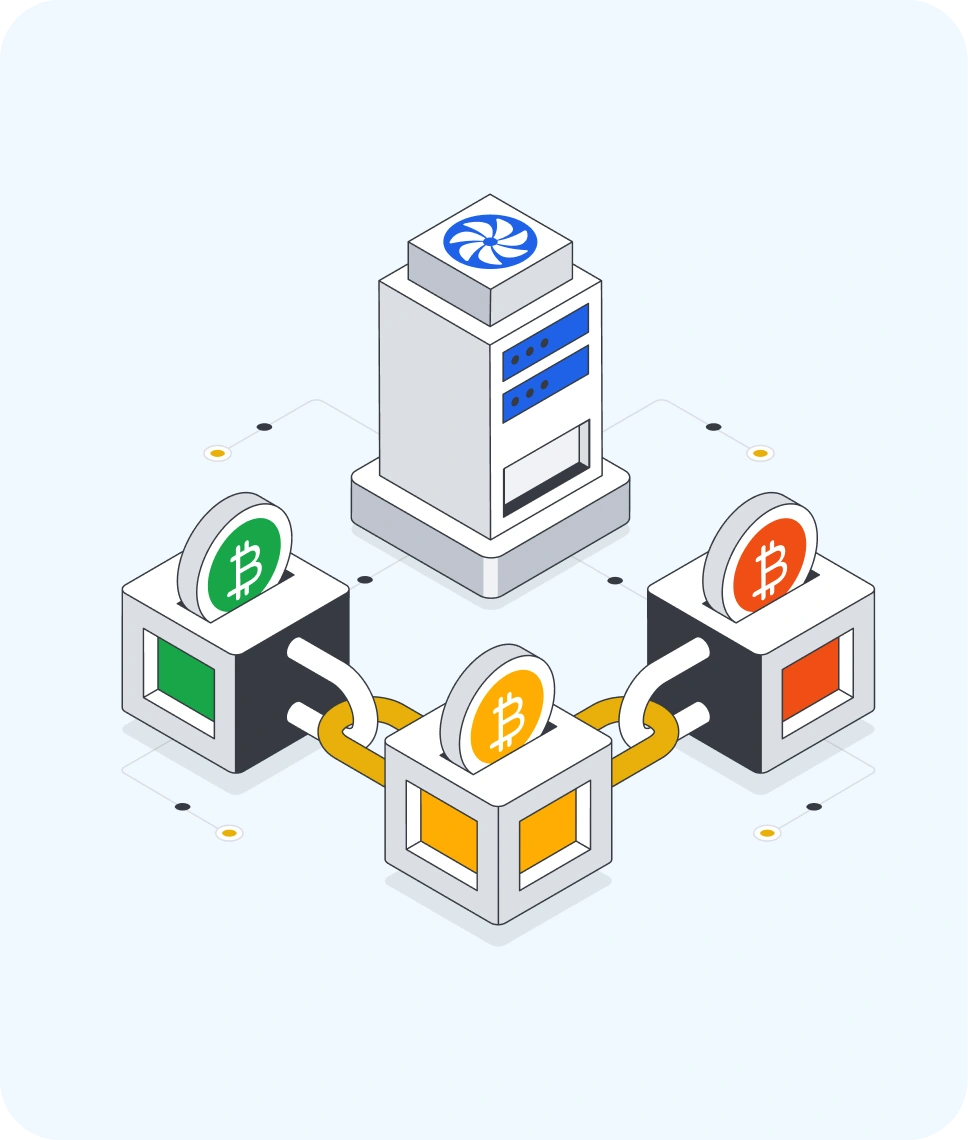In the year 2025, the app development sector in Canada is alive and good. Established technological ecosystems, such as Toronto and Vancouver, and with the development of new people across the country, organizations move quickly to mobile applications to contact customers, to streamline business processes and remain competitive. But just how expensive is it to realize your app concept in Canada? The app development cost in Canada is projected to contribute to a market size of USD 10.79 billion by 2027, marking a 27% increase from previous years.
Whether you are a startup founder, an already established organization or a digital marketer, understanding the breakdown of app development cost in Canada is useful. In this article, we will break down all the different factors about app development costs in Canada including developer hourly wages, the size of the project, and the current tech trends to watch for in the industry in 2025. Let’s get started and take a look at what it will take to turn your app aspirations into sponsored reality in 2025.
How Much Does it Cost to Develop a Mobile App in Canada?
An application that contains basic features in Canada will see the mobile app development costs range from CAD 10,000 to CAD 50,000. The app development cost in Canada for medium-complexity apps (those that include more features and integrations) will be CAD 50,000 to CAD 100,000. High-complexity applications — those apps that may have included cutting-edge technologies like AR or ML, and/or have a lot of database functionality for integration — will range from CAD 100,000 to CAD 500,000 and upwards. The above costs are averages and can change depending on the details of the project, and the region in Canada of the app development agency.
Mobile App Development Cost Defined by Product Complexity
The following table yields a full and detailed view of the approximate costs of mobile applications, based on the Canadian market. Such an estimate pays close attention to several key factors that impact costs profoundly. These range from the application’s design and functional complexity to the choice of platforms for which the application is being implemented (iOS, Android, or both), as well as the sophistication and advanced features expected for end-user requirements when using professional app development services.
Mobile App Development Price Defined by Operating System
| Product Complexity | iOS | Android | Both |
| Basic Application | CAD 10,000 – CAD 50,000 | CAD 10,000 – CAD 50,000 | CAD 20,000 – CAD 80,000 |
| Medium Complexity | CAD 50,000 – CAD 100,000 | CAD 50,000 – CAD 100,000 | CAD 80,000 – CAD 150,000 |
| Highly Complex | Above CAD 100,000 | Above CAD 100,000 | Above CAD 150,000 |
Mobile App Development Cost Defined By App Type
There are a variety of types of mobile applications with distinct characteristics and needs. Accordingly, the costs of development differ substantially depending upon the nature of the application one is developing. The following table provides an outline of the app development cost in Canada for varying types of applications:
| App Type | Approximate Cost Range |
| Game | CAD 50,000 – CAD 250,000 |
| Social Media | CAD 80,000 – CAD 200,000 |
| E-commerce | CAD 50,000 – CAD 150,000 |
| Utility | CAD 20,000 – CAD 100,000 |
| Education | CAD 30,000 – CAD 120,000 |
| Entertainment | CAD 50,000 – CAD 200,000 |
| Productivity | CAD 30,000 – CAD 100,000 |
1. Offline Standalone App Cost
These apps work and function when users do not have or have access to limited connectivity. They were designed to have core app functionality irrespective of the user’s connectivity. With limited need for a real-time backend and updates, they are cheaper and easier to develop.
Estimated Cost: CAD 20,000 – CAD 80,000
Ideal For: Tools, utilities, basic productivity apps
2. Apps Requiring Moderate Online Connectivity
These apps combine offline purposes with online features such as transactions, information and content synchronization. Development includes both front-end and back-end system, increasing complexity.
Estimated Cost: CAD 50,000 – CAD 200,000
Ideal For: E-commerce, social media, content platforms
3. Chatbot apps
Powered by AI and NLP, these apps user interactions on message platforms. Large stages include training models, building conversations and platform integration.
Estimated Cost: CAD 80,000 – CAD 250,000+
Ideal For: Customer support, lead generation, productivity tools
4. IoT or wearable applications
These apps may be connected to a smart device or wearable. They are able to collect sophisticated and timely use of data and required security for the data connection(s).
Estimated Cost: CAD 100,000 – CAD 300,000+
Ideal For: Health & fitness, smart home, geolocation tracking
5. Messaging Applications
Chat apps are more difficult to develop because of the requirement for encryption, multimedia support or interactions, and friendly user interfaces. They created during this phase a focus on performance deliverables but also scale for usage and implementation protection.
Estimated Cost: CAD 150,000 – CAD 400,000+
Ideal For: Communication platforms, collaboration tools
6. Augmented Reality Apps
AR apps blend real-world environments with digital overlays using computer vision and 3D modeling. They require high design precision and processing power.
Estimated Cost: CAD 120,000 – CAD 500,000+
Ideal For: Gaming, education, healthcare, retail
7. Enterprise Mobile App Development
Enterprise apps focus on integrating existing systems and expediting business functions. They also involve some complexity around user roles, security/stability, and structure deployment via cloud servers.
Estimated Cost: CAD 150,000 – CAD 500,000+
Ideal For: Internal tools, employee dashboards, workflow automation
Mobile App Development Cost by Team Type
The cost and quality of mobile app development are influenced significantly by the type of team you choose. Here’s a breakdown of each team type:
| Team Type | Description | Estimated Cost Range |
| Internal Team | Full-time, in-house developers and designers directly employed by your company. | CAD 150,000 – CAD 500,000+ |
| Software Development Agency | A professional firm offering end-to-end development services. | CAD 75,000 – CAD 400,000+ |
| Freelancers | Regionally, independent contractors are hired per project or task. | CAD 10,000 – CAD 80,000+ |
Mobile App Development Costs by Location
Where the development team is located can significantly change the overall project cost of mobile app development. Important considerations that impact the app development cost in Canada include labor costs or “wages,” the size of the talent pool in the region, and the previous experience of app development teams in meeting local demand.
Mobile App Development Costs by City
| City | Hourly Rate (CAD) |
| Toronto | $100 – $200 |
| Vancouver | $90 – $180 |
| Montreal | $80 – $160 |
| Calgary | $70 – $150 |
Step-by-Step Mobile App Development Process to Get Started: Stage By Stage Cost Analysis
By understanding your costs through stages of mobile app development, you will be able to budget your development costs effectively. Below is a simplified approach for each phase and its estimated percentage as part of total project costs or the overall app development cost in Canada.
1. Discovery Phase
Estimated Cost: ~20% of Total Budget
This initial stage sets the foundation. It includes researching market demand, defining goals, outlining core features, and developing basic wireframes or prototypes.
Discovery Phase Breakdown
| Activity | Description | Cost Share (% of Discovery Phase) |
| Market Research | Analyze market trends and competitors | 30% |
| Goal Definition | Define clear, measurable app objectives | 15% |
| User Persona Creation | Create user profiles for design focus | 20% |
| Feature Specification | List of key app features | 20% |
| Prototype Creation | Develop wireframes or low-fidelity UI prototypes | 15% |
2. UI/UX Design Phase (20% of Total Mobile App Development Cost)
The purpose of this phase is to develop a prototype that is a true representation of the ultimate product, with a good user experience. The UI/UX phase usually makes up about 20% of the total mobile app project budget.
Once the app is built, it must then be submitted to the app stores for approval. How long that will take is dependent on the app stores’ policies and processes. In general, approval could take anywhere from an average of 3 days to about a month with professional app development services.
3. Coding Phase (50% of Total Mobile App Development Cost)
Estimated Cost: ~50% of Total Budget
This is the most difficult part from the resource point: Developers distribute both front and back end, integrate third-party APIs and use core features such as push notifications, purchasing in the app and user approval.
- Frontend Development: User interface and animations
- Backend Development: Server, database, APIs
- Platform-Specific Code: Swift (iOS), Kotlin/Java (Android)
- Integrations: Payment gateways, social login, etc.
4. App Launch (10% of Total Application Development Cost)
Estimated Cost: ~10% of Total Budget
This phase includes app store submission, final testing, bug fixing, performance optimization, and marketing.
- Store Compliance & Submission: Ensure the app meets guidelines (3 days to 4 weeks for approval)
- Final QA Testing: Detect and fix critical bugs
- Performance Optimization: Enhance speed and reliability
- Marketing & Promotion: Optional, for boosting visibility
Also, read: What is the AR Zone App? A Brief Guide 2025
Cost of App Development By Examples
Here are some cost estimates of app development to give you an idea of app development costs according to different types of applications and their complexities:
Example 1: How Much Does it Cost to Create a Fintech App Like Wealthsimple?
- Platform: iOS and Android
- Features: Automated investing, financial goal tracking, cryptocurrency trading, tax filing support
- Complexity: Medium
- Estimated cost: CAD 50,000 – CAD 100,000
Example 2: How Much Does it Cost to Create a Social Media App Like Instagram?
- Platform: iOS and Android
- Features: Photo sharing, filters, direct messaging
- Complexity: High
- Estimated cost: $100,000-$250,000
Example 3: How Much Does It Cost to Develop a Delivery App like SkipTheDishes?
- Platform: iOS and Android
- Features: Real-time GPS tracking, route optimization, order scheduling, push notifications
- Complexity: High
- Estimated cost: CAD200,000-CAD500,000
Example 4: How Much Does It Cost to Build an App Like Tinder?
- Platform: iOS and Android
- Features: Swipe matching, chat messaging, location-based features
- Complexity: High
- Estimated cost: CAD150,000-CAD300,000
Example 5: Cost of Developing an App like Netflix
- Platform: iOS and Android
- Features: Streaming, content recommendation, user profiles
- Complexity: High
- Estimated cost: CAD250,000-CAD500,000
Top Factors That Impact Your Mobile App Development Cost
App development costs are determined by many key factors. These factors, when known, will help you better manage your decision-making process and budget.
Factor 1: Business Logic of the App
The core abilities of your app will dictate the cost of your app. Simple apps with simple features can be developed in less time, saving on costs. Whereas, if your app has core workflows, real-time abilities like user-driven experiences, or processing algorithms, it will take longer and require additional development to properly consider the costs of the project.
Factor 2: Technology Architecture and Platform
The choice of platforms (iOS, Android, or both) and the development approach (native versus cross-platform) will also affect pricing. Native applications tend to have much better performance, though their approval procedures for separate code bases complicate the process with added costs. Cross-platform may lessen some time and cost of development. Further, if emerging technologies like AI, AR/VR, or blockchain are being exploited, such app development would need specialized skills in coding; hiring such developers through professional app development services would take additional resources and incur costs.
Factor 3: UI/UX Design Complexity
Design is also a big part of costs. Basic designs with basic interfaces using templates take less time and cost less. Custom-designed applications with features like animations, advanced transitions, and interactivity require increased design hours, and required creative input increases overall costs with more resources that have to be hired to have a specialized designer on the project.
Factor 4: Core Features of the Mobile Application
The development time and cost of your app is directly related to the facilities and complexity of these features. If you include things like real-time chat, push notification, geolocation and shopping in the app, the list of the needs of backend integration and decisions will increase your development time and costs. Several functions simply create more complexity, which will expand the deadline and require a wide range of technical knowledge, skills and resources.
Factor 5: Infrastructure Services
Your app’s backend infrastructure needs ongoing resources for smooth operation. These include:
| Component | Details | Estimated Cost |
| Hosting | Depends on service quality and app size | Shared hosting: Low cost
Dedicated/cloud hosting: Higher cost |
| Data Storage | Based on data volume and usage | Up to 10 GB: $5–$50/month
10–100 GB: $50–$500/month |
| API Integrations | Charges vary by provider and usage model (per request or subscription) | Depends on volume and type |
| Development Tools (IDEs) | IDEs can be free or subscription-based with extra features | Varies from $0 to hundreds/month |
| Scalability Needs | Higher traffic demands may require server upgrades, performance tuning, etc. | Cost increases with user growth |
Native vs. Hybrid Cost of App Development
Choosing between native and hybrid development is a key decision in mobile app strategy. Here’s a breakdown of how they compare:
| Aspect | Native App Development | Hybrid App Development |
| Definition | Separate apps built for iOS and Android using platform-specific languages. | A single app developed using web technologies, deployed across platforms. |
| Languages Used | Swift/Objective-C (iOS), Java/Kotlin (Android) | HTML, CSS, JavaScript (with frameworks like Flutter and React Native) |
| Codebase | Separate codebase for each platform | Shared codebase across platforms |
| Performance | High performance and full access to device features | Moderate performance; limited access to some native functionalities |
| User Experience (UX) | Superior, platform-optimized UX | Uniform UX across platforms; may lack native feel |
| Development Time | Longer due to platform-specific builds | Faster due to code reusability |
| Cost | Higher—essentially double for both platforms | Lower—single team, shared development effort |
| Best For | Performance-critical, complex, or user-sensitive apps | MVPs, content-based, or budget-conscious projects |
Hidden App Development Costs You Shouldn’t Ignore
When budgeting for app development, most teams forget to include important post-launch and indirect expenses. These hidden costs can affect your timeline and profitability if not anticipated in advance. Some of the most important hidden costs to keep in mind are listed below:
1. App Maintenance
What It Covers:
Regular updates, bug fixes, compatibility with OS updates, and feature enhancements based on user feedback.
Why It Matters:
Ongoing maintenance is crucial to keep your app functional, secure, and aligned with evolving technologies.
Estimated Cost:
15%–20% of initial development cost annually
2. Marketing & User Acquisition
What It Covers:
App store optimization, social media advertising, influencer collaborations, email marketing, and PR.
Why It Matters:
Even the greatest app requires visibility. Without proper marketing efforts, user downloads and activity can plateau.
Estimated Cost:
Varies widely—from CAD 5,000 to CAD 50,000+ depending on strategy
3. Legal & Compliance Fees
What It Covers:
Trademark registration, copyright protection, privacy policies, terms of service, and compliance with local data laws (e.g., GDPR, CCPA).
Why It Matters:
Not protecting your IP or following legal regulations can result in lawsuits, bans, or app store rejections.
Estimated Cost:
CAD 2,000 – CAD 10,000+ depending on legal complexity
4. Infrastructure & Hosting
What It Covers:
Cloud hosting, data storage, API usage fees, server management, and scalability upgrades.
Why It Matters:
As your application grows users, infrastructure needs to scale to accommodate higher demand, which has a direct impact on cost.
| Service | Typical Monthly Cost |
| Hosting | CAD 20 – CAD 1,000+ |
| Data Storage | CAD 5 – CAD 500+ |
| API Integrations | Varies (subscription or per-use) |
Tip:
Include at least 25%–30% of your overall development budget in these hidden costs to remain competitive and create a sustainable app business.
Precisely Estimating Your Project Cost
Estimating the cost of mobile app development involves several factors, such as complexity, features, platforms, and team size. A general approach is to break down the project into phases and estimate the costs for each.
For example, if your project requires 500 hours of design work at $50 per hour and 1000 hours of development work at $100 per hour, the total cost would be $75,000—calculated as ($50 x 500) + ($100 x 1000).
This estimate is a rough guide, and the final cost can vary based on your project’s specific requirements.
1. Prepare a List of Tasks, Developers, and Resources Needed
To ascertain an accurate estimate for your project cost, make a contemporary list of all the work, developers and resources needed, such as designers, developers, testers, project managers, and tools or licenses for software. Consider potential obstacles that could impact time or expense, and try to build room for flexibility in your estimate.
2. Choose an Estimation Method and Make Your Calculations
With your list of tasks and resources in hand, select an estimation technique. Some of the popular techniques are:
- Ballpark Estimate: A rough, quick estimate from similar previous projects. It is good for initial planning but not very precise.
- Parameter-based Estimate: Utilizes certain project parameters (size, complexity, effort) to give a better estimate but is still based on assumptions that might influence the ultimate budget.
- Three-point Estimate: Applies optimistic, most likely, and pessimistic values to produce an average estimate. This provides a better balanced view, including best- and worst-case possibilities.
3. Track Budgets and Monitor Progress
Following budget estimates completion, track costs during the project. Review the budget at regular intervals to identify unstated weaknesses and re-evaluate accordingly. This allows for better management to keep the project on track, minimize expenses, and occur sooner on any budgetary deviations.
How to Keep App Project Development Cost Low
Even though project budgeting is a vital component of app development, there are ways to keep the overall cost of a project minimal. Some of them are:
1. Discovery Phase
The discovery phase plays an important role in defining precise project goals and creating a specific roadmap. It entails extensive research, user needs understanding, and early detection of possible challenges. By fixing things early on, the phase ensures that a solid foundation for the project is built up, saving resources and keeping the project on track with its objectives as well as cost.
2. Use the Right Vendor
Selecting the right vendor can significantly impact your project’s cost-effectiveness. Research potential vendors thoroughly by evaluating their expertise, experience, and past work. A well-established vendor with a strong track record will likely deliver high-quality work on time and within budget. This reduces the risk of project delays and unforeseen costs, ensuring smoother execution and higher value.
3. Offshore Outsourcing
Offshore outsourcing is an inexpensive choice, permitting you to access cheaper labor costs and specialized expertise. Yet, it involves management of communication and cultural differences. Having clear procedures, establishing expectations, and regular contact are the key to ensuring successful partnership. By besting these issues, you can save big without sacrificing quality or time constraints.
4. Create MVP Before Scaling
Building an MVP assists in getting the app up with the minimum necessary features to begin with so you can get the concept tried with actual users. It prevents huge up-front investment and generates good feedback, which can influence additional development. With a concentrated approach to major functions to begin with, you save on pointless features and create an app consistent with what customers will use to start growing bigger.
5. Simple Design and User Experience
Keeping the design simple and intuitive is essential to minimizing development costs and optimizing the user experience. Keeping a clean, intuitive interface ensures simplicity and reduces the necessity for intensive revisions. Prioritizing the critical features and constant feedback from users refines the design and makes the app more effective and avoids wasteful design revamps during development.
6. Regularly Evaluate your Cost and Budget
Regularly checking your budget along the development process catches any inconsistencies early. By tracking expenses versus the original budget, you can adjust and avoid overspending. Prioritizing features of the MVP and delaying non-critical additions makes resources go as far as they can, within budget and without unnecessary financial strain.
7. Plan your Scope and Timeline
Having a defined scope and realistic timelines is essential to managing development costs. A defined scope will help avoid scope creep, where additional features that have not been budgeted for are slipped in along the way, which could trigger delays and additional costs. A timeline will keep the project on schedule, which is especially important to avoid situations where long development cycles and increased resource/expense requirements lead to inflated budgets.
Suggested Article: Top 10 Emerging Mobile App Development Technologies for 2025
Cost of Publishing an App on the Apple App Store and Google Play Store
Publishing an app on the Apple App Store and Google Play Store involves certain costs that developers should be aware of.
App Publishing Fee 1: Developer Account
To release an app, developers need to create a developer account. The Apple App Store charges an annual fee of $99, and with that fee you will have access to analytics on the app, a beta testing program, and other resources. In comparison, the Google Play Store only has a one-time fee of $25, and developers can publish as many apps as they want.
App Publishing Fee 2: Subscriptions and In-App Purchases
Also, both of these platforms take a cut of the revenue for subscriptions and in-app purchases. Apple takes 30% of any and all sales, and Google takes 15% of revenue on the first million dollars made and then, after that, takes 30% as well on everything above that million. Developers will have to think about these costs when creating a price or monetization strategy for their app.
Conclusion:
As the digital landscape continues to change rapidly, businesses must prioritize building cost-efficient and future-proof applications. In order to achieve lasting success, a structured process for app development is important. Having transparency and upfront pricing, tailored strategies, and ongoing support will help create apps that meet immediate business needs while also taking into consideration future trends and understanding the app development cost in Canada. By emphasizing factors such as scalability, performance, and upgrade capabilities, businesses can ensure that applications remain relevant and useful in the future. Furthermore, businesses are also considering a format that emphasizes cooperation with their clients, along with feedback and regular maintenance, to ensure that the app does its job while remaining competitive in the market. With the right plan and awareness of the app development cost in Canada, businesses can build apps that have a long-term impact and contribute to future growth, improving their standing in a digital world.











